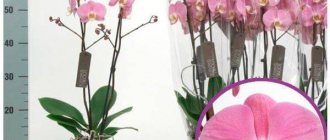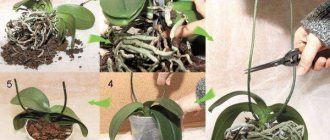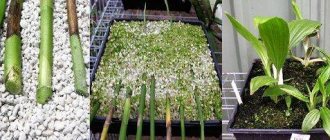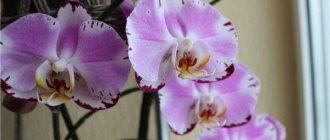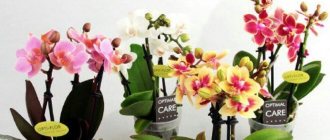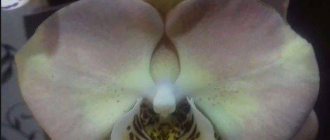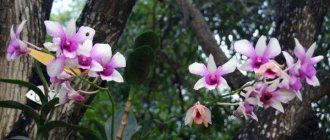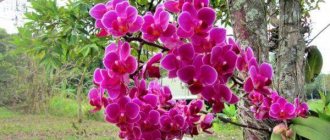Diamond King
Features and external characteristics
Phalaenopsis Diamond King is not a particularly rare variety, but is rarely found in flower shops. Usually having two or three gracefully inclined, straight, peduncles reaching 50 to 70 cm in height in adulthood. Quite a lot of buds are tied on each peduncle.
The leaf is quite large , fleshy, dense. The size of the leaf surface is up to 30 cm in length and 10 cm in width. The number varies from 3 to 5, depending on the care and conditions created.
Diamond King.
The flowers resemble bright burgundy butterflies , with a slightly lightened border. Closer to the center of the flower, leopard-print speckles resembling freckles look original.
Story
There is practically no information available in available sources about the origin of this hybrid. All that is known is that he is British . And perhaps, judging by the shape and appearance of the lower sepals, one of the parents was “Phalaenopsis stuartiana”.
Phalaenopsis stuartiana.
Colors
The main color is bright burgundy. Depending on conditions, soil, watering and fertilization, shades may change to light or dark. Often the flowers acquire a cherry color, with creamy tan marks.
The flower border is always lighter than the main color. And above the lip, in the center there are dark yellow spots.
Features, flowering duration and dormant period
It blooms for quite a long time, 3-4 months . Like all orchids of this type, 2 times a year.
With proper care and creation of normal, close to natural conditions, it can bloom 3 times.
Some gardeners cause artificial flowering , but frequent use of this method threatens to deplete the plant.
Flowering on the peduncle occurs almost simultaneously.
During this period, a new peduncle may appear, which can form buds and flowering will continue almost continuously.
The dormant period begins after flowering, before the formation of new buds or the appearance of a new peduncle to replace the one that has lost its vigor.
The video shows advice from an experienced gardener on how to replant the Daimon King orchid at home:
Obstinate beauties - orchids
Diamond King
A small part of my collection is occupied by orchids. Moreover, this direction began to actively grow only last year. Previously, I was sure that orchids are capricious, complex and delicate.
There were only two such girls in my house - one was given to me, and the second to my mother.
I didn’t have any special love for them, because after they bloomed, there were branched leaves and green flower stalks sticking out, which did not want to turn yellow and die. I didn’t like the spectacle at all.
But at the beginning of last year I discovered a world of variations and colors, varieties and types.
It turned out that in our stores they sell such banality, but the world of orchids is much more diverse and wider! You might have come across pages of girls or shops on social networks that bring orchids from Holland.
This is a very common occurrence in Ukraine; many such sellers have appeared. And their choice is much more interesting than in our florists and supermarkets.
So, one after another, phalaenopsis began to appear in my house. Let's deviate a little into terminology and classification. All classifications contain my favorite criterion - size! So, orchids are classified by size into: 1.
Standard - large leaves, usually one or two not very branched peduncles with large flowers. 2. Midi - medium size, leaves are slightly smaller than the standard, but the height of the peduncle and the size of the flowers are smaller. 3.
Mini - small leaves, low peduncle, small 3-5 cm flowers. There is also a fourth type, but it is not related to the size of the plant, but rather to the abundance of flowering, this
4.
Multiflora - in size it looks like a midi orchid, but the peduncle is highly branched and strewn with a large number of small flowers. My favorite size, so to speak)
Phalaenopsis
Of course, the first thing I noticed was standard orchids.
My first orchid
Pear Lion
Mom's orchid
Charmer
... Then a cloud of flowers caught my attention - I started buying multiflora. I like the compactness of the rosette - the leaves usually protrude slightly beyond the edge of the pot. I also like the abundance of flowers.
Pink multi
Sogo Twilight Rei
Multiflora resemble a flock of butterflies that swarm around flowers.
Of course, I didn’t shy away from midi-sized orchids if the colors seemed interesting to me. This is how the following flowers appeared in my house:
No name
Taida Zebra
Wine stains
But the orchid, which is in the photo below, is truly the star of the collection. The color was so rare among sellers that I hunted for it for over a year.
Intrigue
A very interesting Mini Mark orchid. Many people criticize it for the small volume of the bouquet and small flowers, but I found everything I needed in it. The rosette is compact and does not grow many leaves. The peduncles are low, the flowers are very pretty, with a cheerful orange lip and red hemp.
Mini Mark
There are, of course, a number of shortcomings, but they are not significant for me. These include: - rather rare placement of flowers on the peduncle, - low stress resistance during shipment, be prepared that all flowers and buds will be dropped,
- capriciousness in care (or I just don’t have straight arms))).
Now I am on my second attempt to raise Markusha. The first one ordered to live long. But I can’t stay without him! The portions of tenderness that he gives me are simply enormous!
But let's get back to theory. There is another classification of Phalaenopsis orchids, namely by flower shape. I’ll tell you a little more about the structure of an orchid flower using this photo as an example. So, the petals are called Petalium and Sepalium.
The lower bent part is called the Lip, and the protruding nose is called the Column.
The structure of an orchid flower
https://www.youtube.com/watch?v=gKB2tOk6310
The following varieties of orchid flowers are distinguished: 1. Standard - when all the orchid petals are equally developed and have approximately the same size. Photo above.
2. Butterfly - a type of flower when a characteristic pinch appears on the petals - as if someone pinched the petal and a mark remained. I love these flowers the most! Examples of this flower shape are below.
Legato butterfly
In the photo from Legato, the tucks are visible and the shape of the petals has become a little ragged, similar to a butterfly wing, but the size of the petals has not changed much.
Another butterfly
Butterfly
Another option
3. Babulette is a type of butterfly in which the size of the petal changes significantly. Unfortunately, I don't have any grannies in my collection because I don't find them attractive. The deformed petalia looks underdeveloped.
4. Peloric form (or simply peloric) - a flowering variant when both petals do not open, but remain covered, framing the column.
Peloric flower
Peloric
5. Trilips is a flower whose petals take the shape of a lip. No matter how you turn the flower, it always seems to have a lip.
Phoenix
The photo above is not quite a classic trilips. A combination of Trilips and Peloric. The petals took the shape of a lip, but did not open completely.
Phoenix
6. Biglip is a mutation of the flower's lip. It expands and begins to resemble petals. A very beautiful and unusual type of flower. I don’t have biglips in my collection either, so I can’t show you a photo.
They say orchids don't smell. But among them there are those who emit a fairly strong odor in the bright sun. It's difficult to describe. They remind me of some soapy, perfumed aromas. I have two such fragrant orchids - the Phoenix, which is in the photo above, and the miniature Pink Girl.
Pink Girl
I found it in the supermarket just by the smell. Near the stand with orchids, I could clearly hear the smell of some kind of cosmetic product, either shampoo or shower gel... Starting to look at the plants, I discovered two modest bushes of delicate pink light. And when I took a closer look at them, I realized where the aroma was coming from.
It is noteworthy that the smell intensifies many times in the bright sun and can be heard all day. While Phoenix smells only in the first half of the day. They say that Mini Marks of a certain line also have a smell, but mine don’t have it.
And, continuing the conversation about the fragrant representatives of the Orchid family, I would like to move on to other types of orchids.
Oncidiums
Lately, sellers have been trying to diversify their range of colors, because we, buyers, are becoming picky and looking for something different. And now Oncidiums, another type of orchid, appeared on sale. They grow radically differently and also look unusual.
Oncidium Twinkle
In oncidiums, the “body” consists of pseudobulbs and leaves. They do not grow in bark, like phalaenopsis, but in coconut substrate. The flowers are very small, collected on a thin peduncle. Oncidium Twinkle flowers have a distinct aroma. But it doesn’t seem pleasant to me, as they write in various sources. Rather, the smell is specific. There are different colors. I had brown, white, yellow and burgundy bushes.
Twinkle
Couple
Twig
Inflorescence
White Twinkle
I am writing in the past tense because they all left me. I didn’t have enough skill and knowledge to create comfortable living conditions for them. Over time, the new growths died and dried out. I wanted to plant all the bushes in one large pot to create a lush colorful bloom. But it didn't work out for me.
Cumbria
And another unusual resident of the orchid corner is the Cambria.
Cumbria Odontioda Glyndebourne Belmonte
It also has pseudobulbs, but they are much larger than those of the oncidium. Flowers about 5 cm in very beautiful colors. I also failed with her.
She, of course, opened a young peduncle, which she had managed to plant in the Dutch greenhouse. But the growth turned yellow and died, and the old bulbs shriveled and dried out.
These are shortcomings in agricultural technology, since such bulbous orchids require drying and periods of watering. But I couldn’t figure out when to water and when to dry them.
Cumbria
There was also a Cymbidium bush. These are the orchids that are often placed in bouquets. But again, his pseudobulbs became a mystery to me. Therefore, we broke up with him.
Over the past couple of months, joint orders of varietal orchids from nurseries in Asia and Germany have become very popular. Their prices are astronomical. And my skills are not enough to risk buying an orchid for 40 euros. Of course, the colors and shapes there are radically different, unique, and unusual.
But I am content with industrial options, which are not inferior in beauty to varieties. Plus, greenhouse Dutch orchids are much better adapted to our climate and changing seasons; there is no need to maintain special air humidity or place them in orchidariums.
Of course, not everything is always rosy. In my conditions, orchids get sick and some die. Now I am fighting for the life of my collection, because an unknown virus came to me from an Asian nursery, which began to kill the plants in just a few days. No experienced keeper can determine what to do in such cases.
I tried many drugs, Aktara (I thought someone was biting the leaves), and Fitoverm (maybe mites?), and broad-spectrum antibiotics (what if it was bacterial?), and fungicides. Nothing affected the speed of the disease, only Fundazol slightly slowed down the deterioration of the leaves.
After treatment, 3 waterings were carried out with ordinary water, without the drug, and the rate of the disease increased again. I don’t know if anyone will survive until spring.
But I am not discouraged. The collection can always be restored if desired!
This is how things are now in my orchid plot. What unusual orchids do you have?
Share photos of your favorites and tell me which of my orchids you also liked?
The entry is posted in the sections: personal experience of readers, my winter garden, indoor plants , orchids , gardena, phalaenopsis, cumbria, oncidiums, care
published on chemicalvet.ru according to the materials 7dach.ru
Published by: Inga Proznich
Source: https://cemicvet.mediasole.ru/stroptivye_krasotki__orhidei
Dendrophalaenopsis
It is necessary to understand and know that Dendrophalaenopsis (Dendrobium phalaenopsis) or double-humped dendrobium is a natural species of orchid from the genus Dendrobium. Some gardeners also popularly call it “Dendrophal”.
Important! It has nothing to do with the hybrid between Dendrobium and Phalaenopsis or the species being crossed between it, since this is impossible to achieve, because they are not in a “closely related” relationship. This is an independent natural species.
But this species has its own hybrids. These are the ones we buy.
Dendrophalaenopsis.
Motherland
The homeland of this family of orchids and natural habitat is Australia, Singapore and New Guinea.
Features and external characteristics
Externally, Dendrophalaenopsis looks like Dendrobium. It has tall, thick bulbs with numerous growing points. But flowering occurs on peduncles, like phalaenopsis.
This perennial orchid has a sympodial growth habit. It has many thick, fleshy-looking shoots - pseudobulbs, which grow on the rhizome (rhizome).
The plant grows quite quickly . With enough light, new shoots can grow throughout the year.
Peduncles are quite long. They grow from the upper nodes. The number of flowers on each peduncle is impressive Depending on the hybrid, flower sizes range from 4 to 8 cm.
Features, flowering duration and dormant period
The color of the flowers of each hybrid can be completely different - ranging from pure white to very dark purple. The abundance of flowering depends on the amount and duration of daylight hours.
Unlike its species relatives, Dendrophalaenopsis does not have a dormant period during low temperatures. The plant is allowed to rest by reducing or reducing watering. Allow the substrate to dry and only then water it a little. In phalaenopsis this is normal maintenance and proper watering.
Varieties of Dendrophalaenopsis.
On average, flowering lasts about 2 months . But with 5-6 peduncles the bouquet looks amazing.
Why do dendrophalaenopsis leaves turn yellow?
The main conditions for the healthy development of a plant of this type of orchid are a sufficient amount of illumination and support for the plant, close to the seasonal climate changes that occur in its natural environment.
Yellowing of leaves can be due to several reasons:
- Increased room temperature;
- Ineffective use of complex fertilizing (overfeeding);
- Disruption of the root system.
The most common reason that new gardeners encounter is problems in the functioning of the root system due to overwatering or after transplantation.
especially careful about watering the plant. In nature, orchids grow on trees and in the open air after rain the roots dry out quite well. Therefore, prolonged exposure of roots to a humid environment leads to their ineffective work.
Watch a video about caring for dendrophalaenopsis at home:
Subspecies Dendrobium "Thailand Black"
This orchid is also called the “Black Orchid”, although they do not have a pure black color due to the fact that there are no pigment genes responsible for this color. This is one of the darkest species of Dendrophalaenopsis, having a dark burgundy or dark purple color.
Dendrobium Thailand Black
It has a high growth rate and relatively long flowering . In certain lighting it looks completely black.
Has an unusual flower shape . The petals are pointed and the leaves are narrow and long. It blooms frequently and quickly resumes flowering, which lasts from 2 to 3 months, depending on the conditions created and appropriate care. Peduncles can reach a length of 70 cm in an adult plant.
Graceful Phalaenopsis Orchid Butterfly
An orchid is an attractive plant that can become a worthy decoration for any room. Thanks to the work of breeders, the South American wild beauty has adapted to home conditions and now anyone can admire it in person if they wish.
Phalaenopsis butterfly orchid
The Butterfly orchid variety has a short stem and wide leaf blades. The root system is powerful, thick, and has a white coating on it. The buds appear on long peduncles.
Differences from ordinary phalaenopsis
The butterfly orchid differs from other existing varieties in the shape of its buds, which in appearance resemble small butterflies of a dark shade.
Some varieties and varieties
Today there are about 70 natural varieties of orchids, with more than 100 varieties additionally bred by breeders. Among the most popular crops are the following varieties.
Black butterfly
The black butterfly has an attractive appearance. As practice shows, color may change depending on lighting. Shades can vary from rich burgundy with a chocolate tint to black.
Diamond King
A distinctive feature of this variety is the rather rich and bright burgundy shade of the buds, while the petals have a light-colored border. The buds reach a diameter of 8 cm.
Manhattan
To date, this hybrid has not undergone the registration process, so it only has a trade name. The buds are light pink, with a large number of small inclusions of burgundy. The core is yellow and orange.
Pavarotti
Phalaenopsis of this variety is known to many gardeners due to its dense, almost monochromatic flowers that have a fairly rich and attractive wine tint. The diameter of the buds can reach 8 cm.
Valencia
It is a very rare variety of orchid, the maximum height is 60 cm including peduncles. The sepals and petals are snow-white, the lip is very large, the inner part is yellow, and the outer part is white.
Kimono
If you look at the photo, you can see that the buds are a rich purple color, the border of the petals is whitish-yellow. At the same time, the veins and tongue are very dark, the central part is crimson. Bud diameter – 7 cm.
Legato
It is a hybrid that differs from other varieties in its unusual shade. The height of the peduncle is about 60 cm. Flowering occurs several times a year and lasts 7-8 weeks.
Peloric
Pelorik does not belong to any of the existing varieties of orchids. This is the name given to crops whose buds have an unusual shape. Such changes occur as a result of mutations.
Habitat area of distribution history of discovery
Phalaenopsis or, as this culture is also called, the butterfly orchid, was first discovered in early 1750 on the island of Ambon by Herg Rumph, who arrived from Germany. The official name was assigned only in 1825 by botanist Karl Blume. Today, about 70 species of crops and about 100 hybrids are known.
What colors are available?
The orchid includes almost all existing colors, ranging from pink to purple. In addition, in nature you can find white and yellow phalaenopsis.
External characteristics
To understand how butterfly orchids differ from other varieties, it is enough to consider their external characteristics.
Mature plant height
There are 4 standards of orchids, the size of which differs significantly:
- Mini – maximum height 20 cm.
- Midi - an adult plant reaches a height of 50-55 cm.
- Regular - able to grow up to 65-75 cm.
- Royal is the tallest variety, reaching 80 cm.
It is recommended to choose pots according to the size of the plant.
Number of leaves
If phalaenopsis does not exhibit pathologies or diseases, then on each shoot you can see from 4 to 6 leaf blades. The leaves are quite fleshy, shiny, and have a rich dark green hue. The growth is carried out alternately, with the upper leaves being much larger in size than the lower ones.
Maximum peduncle length
As practice shows, the length of the peduncle is identical to the height of the plant. The maximum size can reach 100 cm.
Flower shape diameter
The butterfly orchid, a photo of which can be seen below, forms flower stalks, a state of 3 petals. The buds resemble butterflies in appearance and shape. The side petals are the largest, the third is located in the center.
Main features of flowering
Flowering occurs when the plant reaches the age of 2.5-3 years. The beginning of the process is quite problematic to recognize, since at the same moment adventitious roots begin to appear. Peduncles are recognized by their pointed tip and the presence of scales.
Landing features
Planting is carried out only in special soil intended for growing orchids. Transparent containers are chosen for growing so that the roots can fully participate in photosynthesis.
Care: what are the features
The peculiarity of care is that it requires maintaining optimal temperature and humidity levels. In addition, the substrate must be replaced every year.
Growing problems
When growing the grissini peloric butterfly orchid, you may encounter some difficulties. The most common problem is that during growth the crop begins to dry out.
Why do the roots dry out?
As practice shows, the root system begins to rot if the watering system is irregular. Despite the fact that orchids do not need frequent watering, you should not forget about it. Water is added at the moment when the substrate begins to dry out.
Conclusion and useful tips
Very often, when growing orchids, many mistakes are made, as a result of which the plant ceases to please with its appearance. In order to prevent many problems, including diseases, you need to create suitable conditions and follow all recommendations.
Source: https://herbgid.ru/vidy/orhideya-babochka
Wild peach (Phalaenopsis "Wild Peach")
Distinctive features and external characteristics
A distinctive feature of this phalaenopsis is the unusual coloring of the flowers . The shades of flowers largely depend on the conditions of maintenance and care.
Color can vary from orange to pink-orange. The inclusions are brick to burgundy with white dots. The lip of the flower is mostly dark crimson, and the column is bright lilac. See what the Wild Peach orchid looks like in the photo.
Phalaenopsis Wild Peach.
The flowers are quite large . Some plants reach 10.5 cm. The average size ranges from 8 to 9 cm. Peduncles, the number of which can reach 4 pieces, are quite strong and tall.
Story
The history of hybrid phalaenopsis is quite difficult to trace . Hybridization is a fairly long process, starting from natural ones and ending with the hybridization of a number of phalaenopsis with different colors and sizes of flowers, etc.
Surely it could not have happened without Phalaenopsis stuartianum, which became the progenitor of inclusions, spotting and patterns on the petals. Spotted phalaenopsis wild peach, photo below.
Features of flowering, flowering duration and dormant period at home
No peculiarities were noticed in the flowering:
- The duration can also be from 2 to 4 months;
- The rest period cannot be clearly defined by date or season;
- After flowering, the plant needs to grow leaves and root parts;
- Under normal conditions and the necessary temperature changes, phalaenopsis blooms again quite quickly.
Important! If the plant is dormant for a long time, then it is simply tired and needs to gain strength.
And in this video you can look at Wild Peach in more detail:
Description of the orchid
The bush version is extremely rare; stem and vine-like varieties are offered on the market. Everyone is accustomed to the fact that an orchid is an indoor flower that has a unique structure of leaves and stem and blooms beautifully, throwing out a long arrow. In nature, the plant is a sticky plant that is located on tree trunks.
Blooming orchid
There are two groups of orchids - epiphytes and lithophytes. A distinctive feature is the presence of underground tubers or roots, which perform many functions, ensuring the normal functioning of the plant.
Reproduction is carried out by planting children, which can form on the peduncle, at the root, or on the stem.
For your information! In place of the flowers, boxes appear containing several million seeds.
Scientific name
When buying a beautiful pot with an indoor flower, not many people think about whether it is correct: archid or orchid, what is the scientific name of the flower. If you examine the literature on botany, you can find a plant name that is completely unknown to the general public - phalaenopsis.
Sometimes there is a common name that sounds completely new even to experienced gardeners, namely dendrobium. This variant of the name defines the Orchidaceae family, which belongs to the genus of herbaceous plants.
Appearance of an orchid
What does an orchid look like?
Many people are confident that they know and can accurately describe what an orchid looks like. But in fact, there are several variations of this plant, which at first glance completely contradict the appearance presented in pots on the window sills of gardeners.
External data of one of the varieties
Distinctive features of the appearance of the flower:
- the length and shape of the stem can be different - short, long, straight, vine-shaped;
- leaves may have an oval or slightly elongated shape. They are dense, fleshy, emerald or green in color;
- Orchid flowers have a complex structure. The bud consists of several petals of non-standard shape. In addition, the color can be very diverse;
- flowering can occur in a spike, singly or in a brush with several buds arranged along the peduncle;
- the root system is no less impressive. The shoots are thick, usually green or gray-green in color. They resemble crooked tubes.
An orchid flower looks aesthetically attractive on a windowsill, especially during the flowering period. Thanks to the unique combination of diverse flowers and leaves, it is difficult to even imagine what types of orchids there are.
General information on orchids: planting features
Any plant does not like transplantation and reacts negatively with its development for some time. The Dendrophalaenopsis orchid is even more critical of transplants.
It is important to choose a good soil (substrate), consisting of tree bark (preferably pine, but prepared) and other inert components, selected in the correct proportion.
You should also observe:
- The arrival of light
- air circulation,
- Drainage in a flower pot.
Home care rules
Conditions of detention
Caring for modern types of orchids is not very difficult. The main thing is to follow the rules:
- Temperature regime . It is enough to adhere to daytime temperatures of 22-24° C and night temperatures of 15-18° C. Such a difference between temperatures has a beneficial effect on the development and flowering of the orchid;
- Humidity . Air humidity of 40-60% is considered normal. With low or high humidity, growth slows down, flowers begin to dry out, buds fall off, or the color of the foliage changes;
- Lighting. Direct sunlight is strictly prohibited. The plant should be in a well-lit place, but without direct sunlight. Daylight hours should be at least 10 hours.
These conditions are quite easy to establish at home, using in exceptional cases an air humidifier, ventilation or a phytolamp.
Watering and fertilizing
The frequency of watering directly depends on:
- Temperatures
- Lighting,
- Humidity.
The higher the temperature and sufficient lighting, the more often watering is done. The water should be soft and warm (32-34°). It is better to use distilled or rain water.
During the cold season, watering is noticeably reduced.
Proper watering of an orchid.
During the hot period, watering depends on the ability of the root system to absorb and dry the roots. Typically, watering is done once every three days.
Additional nutrition is added during the period of active growth at every third watering. For this purpose, special fertilizers for orchids are used.
Advice! It is better to reduce the proportion recommended by the manufacturer by 2 times. It is better to underfeed than to overfeed an orchid.
Disease Prevention
Basic preventive measures are carried out after purchasing a new pet:
- The substrate changes
- Suspicious areas are treated with fungicidal preparations.
During the growing period, important prevention is compliance with the growing conditions and compliance with the rules of care.
The nuances of transplantation
Any plant has a negative attitude towards transplantation. Acclimatization to new conditions is quite painful and takes a long time.
Therefore, transplantation should be carried out only as a last resort :
- After the purchase,
- If the landing container is cramped,
- For diseases of the root system.
Orchid blossom
How to plant an orchid: examples in a pot and at home
The orchid has a whimsical nature regarding flowering. Many specimens never bloom. There are several ways to make an orchid bloom. You need to create a stressful situation for the plant:
- make sudden changes in temperature;
- stop watering for a week, and then place in warm water;
- increase the dose of fertilizers at the time of feeding.
Features of orchid flowering
But the conditions of care at the time of flowering and after it differ.
Care during flowering
If you properly care for a flowering plant, this period will last a long time. It is necessary to water the flower on time, remove dried and limp buds. You need to feed the plant at least once every 2 weeks.
Caring for an orchid at home after flowering
After flowering, you need to transfer the flower to the dormant stage, and also:
- remove the peduncle by cutting it with a sharp pruner;
- leaves that have withered or dried out must also be removed;
- It is advisable to stop frequent watering and reduce the amount of fertilizing.
For flowering to stop and resume the following year, the plant must rest well during the winter.
You can decorate your home with a blooming orchid of the selected variety if you properly care for the flower. You should first study all the features of the species and choose a suitable place for it in the house.

